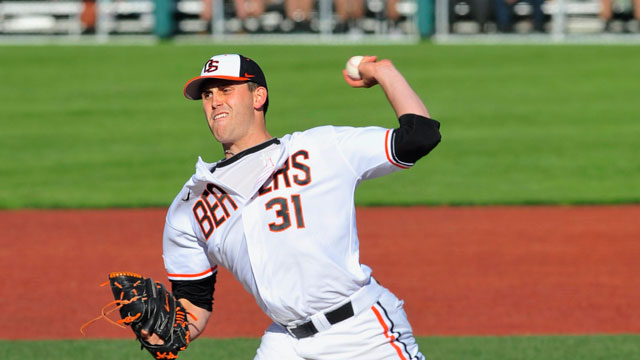TORONTO – A year after basing their draft strategy around creating cap space to pay their early picks above slot, the Toronto Blue Jays took a more balanced approach this time with the potential to pony up dollars for talents that slipped out of the first 10 rounds.
Amateur scouting director Brian Parker, running a draft for the first time, chose 22 pitchers, five shortstops, five outfielders, four catchers and four first baseman with his 40 selections, 19 of them high-schoolers (and only two Canadians, high school right-hander Sean Ratcliffe of Ajax, Ont., in the 18th round and college catcher Mike Reeves in the 21st round).
Several signings are expected in the next few days, and it will be intriguing to watch how much spending room within their draft pool they create.
The Blue Jays chose four college seniors in the top 10 rounds with a total value of $690,300 assigned to their spots, so a significant chunk of change can be saved there with a few $1,000 signings.
Second-rounder Clinton Hollon, whose stock slipped because of a forearm injury last spring, third-rounder Patrick Murphy, who’s coming off Tommy John surgery, and fourth-rounder Evan Smith also may end up signing at a discount, giving Parker a chance to spread some bucks elsewhere.
Lefty Jacob Brentz, an 11th-rounder with a commitment to Missouri State, lefty Eric Lauer, a 17th-rounder bound for Kent State, and righty Sam Tewes, a 22nd-rounder headed for Wichita State, are three picks Parker mentioned as targets. Any bonus in excess of $100,000 paid to players selected in Rounds 11-40 counts against a team’s spending pool.
“Those are three high school pitchers we have some interest in depending on what happens for us in the top 10,” said Parker. “We took the approach this year that we were going to try to get a few of those guys, so we’re hoping to save some money up in the top 10 to give us some flexibility later.”
Rowdy Tellez, a slugging first baseman committed to the University of Southern California, is another interesting possibility after falling all the way to the 30th round.
What happens with Phil Bickford, the right-hander taken 10th overall, may go a long way in determining how all that plays out. Armed with a commitment to attend Cal State Fullerton, Bickford’s been described in some circles as a tough sign but with an assigned value of $2,921,400 to his spot, there’s not a lot of room for him to improve in the draft should he choose to go to college.
The Blue Jays believe he is very signable.
“Especially higher in the draft, the top few rounds, you really need to know on that kind of stuff before you take the kid,” said Parker. “We did our research, we did our background on him and the other guys at the top of the draft and we feel good.
“We’ve started talking to him and his advisor, and we feel good.”
The 19 pitchers the Blue Jays picked – including one in each of the first nine rounds – reflected a point of emphasis for Parker and his staff.
While he insisted that they didn’t go out of their way to choose arms, he made the point that “I don’t think anybody has enough pitching.”
“It’s obvious one of our plans was to target pitching,” he continued. “We’ve traded a lot of pitchers in the past year and that was a focus, we weren’t going to pass on position players if they were better, it just so happened we were able to get some of the young arms that we liked and had interest in.”
Of the 19 pitchers chosen 12 were high-schoolers, among the most volatile of commodities in the draft, yet Parker believes the Blue Jays’ player development system helps mitigate some of that risk. A handful of college senior pitchers – like sixth-rounder Matt Boyd and eight-rounder Kendall Graveman – should help too, he believes.
“They’re college seniors but they’re actually very successful seniors at big-time baseball programs, so those are two college starters that we like and that we think can mix in with the young high school guys,” said Parker. “That’s one of the ways we (managed risk). When you’re at the top of the draft, you don’t want to pass on the better player, better talent, just because of, ‘Well, we’ve already taken three high school guys, we don’t want to take another.’”
GM Alex Anthopoulos echoed that sentiment, laughing as he relayed how pitching co-ordinator Dane Johnson watched the first nine rounds unfold and sent a text asking, “What the hell’s going on?”
“We didn’t set out to say we’re going to take nine arms in the first nine picks, but we didn’t want to force it,” said Anthopoulos. “A lot of times you’re sitting there saying, ‘Well, do we need a shortstop? Do we need a third baseman?’ There are so many failures in the draft you that if you start trying to draft by needs, other than when you’re filling the organization, that’s where you make a mistake.
“You really have to take the best player available. Position players are tough and not many teams have success with it and that’s why you see most position players come in the first two rounds in the draft.”
The Blue Jays didn’t see a position player they wanted that early, so they ended up getting well-armed instead, with an opportunity to make some interesting things happen.


